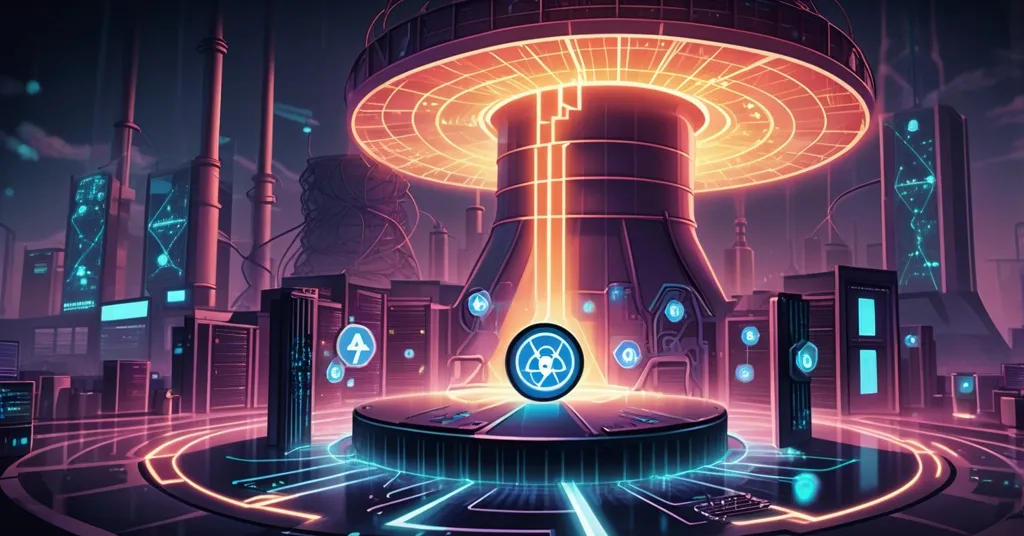Meta’s Nuclear AI Power Play vs. Risky Crypto AI Tokens: Boom or Bust?

Meta Goes Nuclear for AI While Crypto Pitches AI Tokens: Innovation or Insanity?
Meta’s latest power play—a 20-year nuclear energy deal to fuel its AI ambitions—signals a new era for Big Tech’s energy hunger, while the crypto space is riding a wave of AI token hype with projects promising to revolutionize niche markets. But amidst the buzz, are we witnessing genuine disruption or just another speculative bubble waiting to pop?
- Meta’s Nuclear Power Grab: A 20-year, 1.1-gigawatt deal with Constellation Energy to support AI infrastructure starting 2027.
- AI Crypto Frenzy: Tokens like SUBBD, Flock.io, and MIND of Pepe tout big ideas but scream high risk.
- Energy Parallels: AI’s power demands echo Bitcoin mining’s sustainability battles, raising big questions for decentralized tech.
Meta’s Nuclear Bet: Powering AI at Scale
Meta, the tech titan behind Facebook and Instagram, has secured a game-changing agreement with Constellation Energy to tap into 1.1 gigawatts of nuclear power from the Clinton Clean Energy Center in Illinois, kicking off in 2027. This isn’t about directly juicing up data centers—it’s a clever carbon accounting maneuver. Meta is buying “clean energy attributes” to offset its emissions, while the actual electricity still feeds into the local grid. The goal? Fuel the monstrous computational needs of artificial intelligence systems that already shape user experiences on its platforms and aim to fully automate ad creation by the end of 2025. This deal with Constellation isn’t just a tech flex; it’s a lifeline for over 1,100 jobs and a boost of $13.5 million in annual tax revenue for the region, all without leaning on state subsidies or hiking costs for ratepayers.
Why nuclear, though? Unlike solar or wind, which depend on weather and have lower capacity factors (think 25-30% efficiency), nuclear plants run at over 90% capacity, offering a steady, reliable power source for AI’s relentless hunger. Training a single large AI model can emit hundreds of tons of CO2—think 500+ tons for something like GPT-3—and Meta’s not alone in this pivot. Microsoft is reviving a reactor at Three Mile Island, and Meta itself has been scouting for new nuclear facilities capable of 1-4 gigawatts. But there’s a flip side. Nuclear may be low-carbon, but it’s not without baggage—public fears linger post-Fukushima, and some environmentalists argue it diverts focus from renewables like solar. Regulatory hurdles could also slow things down. Is this a pragmatic step toward sustainability, or a risky distraction from greener alternatives? For more on why Meta is turning to nuclear power for AI, the debate continues across various platforms.
AI’s Energy Hunger: Echoes of Bitcoin Mining
The insatiable power demands of AI aren’t new to those of us in the crypto space. Bitcoin miners, running Proof-of-Work (PoW) systems, have been under fire for years over their environmental footprint. A single Bitcoin transaction can consume as much energy as an average household does in days, with mining operations often criticized for relying on fossil fuels. AI’s needs are strikingly similar—training complex models requires vast computational resources, often backed by energy-intensive data centers. Meta’s nuclear move is a nod to scalability challenges that mirror Bitcoin’s own struggles, raising a critical question: can tech, centralized or decentralized, keep growing without cooking the planet? Check out this comparison of Meta’s AI energy demands and Bitcoin mining for deeper insights.
Bitcoin’s community has already been wrestling with solutions. Innovations like renewable-powered mining farms in places like El Salvador, where geothermal energy fuels operations, show that sustainability isn’t just a pipe dream. Ethereum’s shift to Proof-of-Stake (PoS) slashed its energy use by over 99%, proving altcoins can pivot when push comes to shove. But what about AI-blockchain hybrids? If Big Tech needs nuclear reactors to keep up, what does that mean for smaller, decentralized projects trying to integrate AI? It’s a looming hurdle, and one that could either spur creative solutions or sink overly ambitious ventures before they even launch.
Thunder Code: AI Innovation Without the Blockchain Gimmick
While Meta plays the long game with nuclear energy, the startup world is churning out AI innovation at breakneck speed. Enter Thunder Code, a new AI-driven software testing platform founded by former Microsoft engineers Karim Jouini and Jihed Othmani, who previously sold their expense management firm Expensya for over $120 million. Backed by $9 million in seed funding, Thunder Code targets a $100 billion market dominated by sluggish legacy players like Tricentis and BrowserStack. Jouini’s vision is unapologetically accelerationist, focusing on speed and efficiency, as detailed in this update on Thunder Code’s funding and vision.
AI will let Thunder Code generate 10 times the value with fewer people.
That’s Jouini’s take, and he’s not afraid to dilute equity if it builds a unicorn. Their minimum viable product, slapped together in just six weeks, is proof that real disruption doesn’t always need a blockchain wrapper. It’s a refreshing counterpoint to the crypto hype—sometimes, raw engineering and a lean team can outpace tokenized promises. Could Thunder Code’s tech eventually intersect with blockchain, say, for smart contract testing? It’s a stretch for now, but a tantalizing thought for those of us rooting for decentralized systems to infiltrate every corner of tech.
AI Tokens: Innovation or Illusion?
Now, let’s wade into the lawless frontier of digital assets, where AI and crypto are colliding with a mix of intrigue and insanity. Several tokens are riding the AI wave, pitching themselves as the next big thing in decentralized tech. First up is SUBBD Token ($SUBBD), a utility token for a content creation platform that uses AI tools to help creators, influencers, and fans. Priced at $0.055575 during presale, some are hyping a jump to $0.301—a jaw-dropping 441% gain. Then there’s Flock.io ($FLOCK), trading at $0.2579 on exchanges like MEXC and BingX, with a 267% volume spike in a month. It aims to democratize AI through decentralized model training—basically, letting a network of users contribute computing power and data instead of relying on a single tech giant. Finally, MIND of Pepe ($MIND) positions itself as an AI agent for real-time market trend analysis. After raising $12.7 million in presale, it soared 68% to $0.002216 upon listings on Uniswap, CoinMarketCap, and CoinGecko, with a current market cap of $244.37 million. For a closer look at these projects, see this review of SUBBD, Flock.io, and MIND of Pepe.
Hold your horses before dumping your savings into these flashy tokens. Price predictions like a 441% surge for $SUBBD are little more than crystal ball nonsense—pure guesswork masquerading as insight. If I had a satoshi for every absurd gain forecast that tanked, I’d be Satoshi Nakamoto myself. Independent data on $SUBBD and $FLOCK is thin, and $MIND’s presale buzz smells like the same old shilling we’ve seen rip through this space time and again. The crypto market is a cesspool of rug pulls and broken dreams, and AI tokens are far from immune. Yes, the global AI market could hit $1 trillion by 2027 with a 19% growth rate through 2028, and creative tools—a key focus for $SUBBD—make up nearly 30% of the sector. But tying that potential to unproven tokens is a gamble most shouldn’t take without serious research. Dive into this analysis of risks and potential in AI tokens for a broader perspective.
Let’s zoom in on Flock.io for a second. Its pitch—decentralized AI model training—means distributing the workload of building AI across a blockchain network, potentially using Ethereum or a similar protocol for transparency and rewards via tokens. Unlike centralized AI from Google or Meta, where data and control stay locked in corporate silos, this approach could let anyone pitch in, earning $FLOCK for their contribution. Sounds promising for privacy and freedom, right? Sure, if it works. The reality is, we don’t know the tech stack, the adoption rate, or if it’s just vaporware. Execution is everything, and history shows most projects like this fizzle out.
Decentralized AI: Dream or Danger?
Despite the skepticism, there’s a kernel of hope in the idea of AI on blockchain. If done right, decentralized AI could cut reliance on Big Tech’s walled gardens, aligning perfectly with our push for privacy, freedom, and flipping the bird at the status quo. Imagine AI systems not controlled by Meta or Google but powered by community-driven networks where data isn’t hoarded but shared transparently. Flock.io’s concept hints at this future, and $MIND’s market analysis tool could, in theory, arm retail investors with insights—if it’s not just a mirage. These are niches Bitcoin doesn’t touch, and that’s okay. As Bitcoin maximalists, we see BTC as the ultimate store of value and sound money, but altcoins and protocols like Ethereum can fill gaps with specialized use cases. For a broader take, explore this list of top AI cryptos to watch.
Still, the risks are glaring. Beyond price swings, combining AI and crypto opens doors to ethical messes—think market manipulation powered by AI agents or unchecked bias in decentralized models. Regulation is a wildcard; governments can barely handle crypto or AI alone, let alone together. The SEC or EU could clamp down hard, stifling innovation or, frankly, saving investors from scams. And let’s not ignore the energy angle. If AI already pushes Meta to nuclear, what happens when blockchain projects layer on similar demands? It’s a puzzle with no easy answers, and one that could make or break this hybrid space.
Lessons from Bitcoin and Beyond
Bitcoin remains the bedrock of this crazy ecosystem for a reason—it’s battle-tested, a true middle finger to centralized finance. Its energy debates have forced ingenuity, from green mining farms to off-grid solutions, setting a template for how tech can adapt under pressure. AI tokens and altcoins might carve out their corners, but they’re playing catch-up in a space where trust is hard-earned. Meta’s nuclear leap shows Big Tech’s commitment to dominating AI, while startups like Thunder Code prove you don’t need a token to disrupt. The question is whether decentralized AI on blockchain can live up to its lofty ideals or if it’s just another fad destined to fade into obscurity. For a community perspective, check out this Reddit discussion on Meta’s nuclear power strategy for AI.
We’re all in for accelerating tech that breaks the mold—effective accelerationism is the name of the game. But let’s not drink the Kool-Aid blindly. Most AI-crypto projects could crash spectacularly before they deliver, and even Meta’s “clean” energy play isn’t without critics. The future of money and tech is dazzling, but the path is littered with traps. Keep your head on a swivel and your wallet locked tight. For some background on the broader context of AI’s growth, take a look at this overview of the AI boom.
Key Takeaways and Questions to Chew On
- Why is Meta turning to nuclear energy for AI?
Meta needs a reliable, high-capacity power source to meet AI’s massive computational demands, using a 1.1-gigawatt deal starting in 2027 to offset emissions through clean energy credits while supporting jobs and tax revenue. - What drives AI’s huge energy needs, and how does it compare to Bitcoin?
Training AI models consumes vast power, similar to Bitcoin mining’s Proof-of-Work system, raising sustainability concerns as both technologies scale, though Bitcoin has spurred renewable innovations as a response. - Are AI crypto tokens like $SUBBD, $FLOCK, and $MIND a good investment?
They pitch innovative ideas like content creation and market analysis, but unverified data and wild price predictions (like 441% gains) scream high risk—proceed with extreme caution and deep research. - Can decentralized AI on blockchain uphold privacy and freedom?
Potentially, by reducing dependence on centralized tech giants and enabling community-driven systems, but unproven execution and ethical risks like manipulation remain massive hurdles. - What are the regulatory risks for AI-crypto projects?
Governments lag in regulating either field, so combining AI and crypto could face harsh crackdowns, either stifling growth or protecting investors from rampant scams. - How does Bitcoin’s role differ from AI-focused altcoins?
Bitcoin stands as the gold standard for sound money and store of value, while altcoins and AI tokens explore niche use cases—valuable if they deliver, but speculative compared to BTC’s proven track record.



